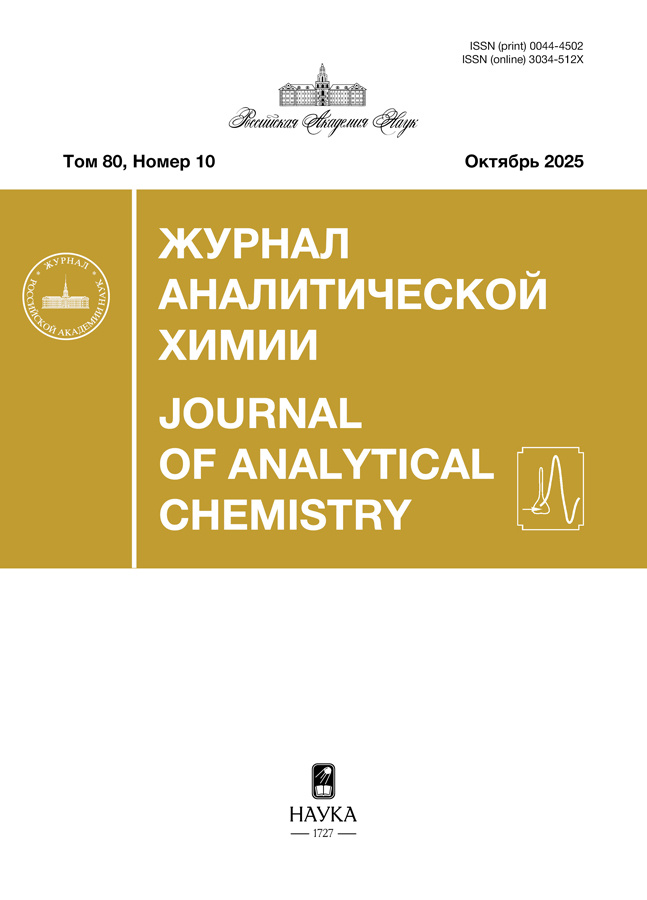Zhurnal Analiticheskoi Khimii
ISSN (print): 0044-4502
Media registration certificate: No. 0110234 dated 02/09/1993
Founder: Institute of Geochemistry and Analytical Chemistry named after. V.I. Vernadsky RAS, Russian Academy of Sciences
Editor-in-Chief: Kolotov, Vladimir Panteleimonovich
Number of issues per year: 12
Indexation: RISC, list of Higher Attestation Commissions, CrossRef, White List (level 3)
Current Issue
Vol 80, No 10 (2025)
REVIEWS
Chemometrics for optical spectral analysis of multicomponent mixtures
Abstract
Modern optical spectroscopy effectively solves the problems of quantitative and qualitative analysis of multicomponent mixtures with complex chemical and morphological composition. Many natural and man-made samples require direct analysis without separation into components or complex sample preparation, and often without the possibility of physical sampling. This has become possible thanks to the technical improvement of analytical instruments on one hand, and the development of mathematical methods for analyzing multidimensional data (chemometrics) on the other. This review focuses on the most important chemometric algorithms in terms of their contribution to the creation and advancement of optical spectral methods for analyzing multicomponent mixtures. Emphasis is placed on molecular spectroscopy in the ultraviolet, visible, and infrared regions, where, due to significant overlap of absorption (or emission) bands, the accuracy and robustness of the analysis results heavily depend on the mathematical tools used. The article presents foundational theoretical information that provides insight into the effectiveness of the discussed methods and algorithms in building models for calibration, classification, and exploratory analysis of multidimensional data. Some of the material is presented in Russian-language scientific literature for the first time. Illustrative examples are provided showing the application of optical spectroscopy and chemometrics to solve real-world analytical problems in the chemical, food, and pharmaceutical industries, as well as in environmental and medical fields – without prior sample preparation.
 1007-1030
1007-1030


The extraction freezing method: twenty years of development
Abstract
This article reviews the results of twenty years of development of the extractive freezing-out method. The novel principle of extraction is based on low-temperature isolation of target components via redistribution of dissolved substances between the liquid phase of a pre-added non-freezing hydrophilic solvent and the forming solid phase of ice during freezing. A major advancement in the method was the introduction of extractive freezing-out under the influence of centrifugal forces (EFC). Implementing EFC as a sample preparation step in various methods for determining organic substances has enabled the successful integration of the technique into chemical-toxicological analysis, food quality control, environmental monitoring, and hydrochemical studies. The article demonstrates the advantages of the developed extraction method in comparison with traditional techniques such as liquid–liquid extraction, headspace analysis, and solid-phase extraction. It also outlines the near-term prospects for further development.
 1031-1044
1031-1044


ORIGINAL ARTICLES
Application of mimetic analogs for the preparation of a bioinorganic sorbent modified with imprinted proteins
Abstract
A method has been developed for obtaining a specific bioinorganic sorbent based on silicon dioxide (IV) particles modified with an imprinted protein (IP). Bovine serum albumin was used as the template protein molecule. The imprinting was carried out in the presence of a series of template molecules – coumarin, 4-hydroxycoumarin, quercetin, and 5,7-dimethoxycoumarin –which act as mimetic analogs of the mycotoxin zearalenone. To preliminarily assess the possibility of substituting zearalenone with mimetic analogs and to select the optimal template molecule concentrations during IP preparation, computational chemistry methods were used (molecular docking and molecular dynamics). The need for prior surface modification of the silicon dioxide (IV) particles to produce sorbents based on IPs was demonstrated. The potential application of the resulting bioinorganic sorbents for solid-phase extraction of template molecules from model solutions was validated for coumarin (Q = 2.0 mg/g), 4-hydroxycoumarin (Q = 1.2 mg/g), quercetin (Q = 0.8 mg/g), 5,7-dimethoxycoumarin (Q = 2.2 mg/g), and for zearalenone (ZEA) from wheat extract (Q = 4.79 mg/g, IF = 2.45). Sorption isotherms were constructed for ZEA on the IP-modified sorbents obtained using different mimetic analogs. Cytotoxicity of the IPs was studied, and biosafety was assessed using the AGREEMIP tool.
 1045-1055
1045-1055


Micellar-extraction express determination of certain pharmaceutical arylamines
Abstract
 1056-1065
1056-1065


Study of organic matter distribution on human skin surface using oxithermography
Abstract
 1066-1071
1066-1071


Identification and chromatographic determination of certain functional additives in mineral hydraulic oils
Abstract
 1072-1081
1072-1081


Application of untargeted GC-MS analysis for the identification of cancer biomarkers among steroid hormones in human urine
Abstract
 1082-1091
1082-1091


Application of [(2-hydroxybenzaldehyde)-3-isatin]-bis-hydrazone for photometric determination of palladium(ii) in nickel anode material
Abstract
 1092-1099
1092-1099


Determination of the impurity composition of boric acid by inductively coupled plasma atomic emission spectrometry
Abstract
 1100-1107
1100-1107


Application of Capillary Electrophoresis for the Study of Synthetic Phosphate Degradation in Meat Systems
Abstract
 1108-1114
1108-1114


EVENTS
Y.G. Lavrentiev – 90 Years Since the Birth
 1115-1116
1115-1116













